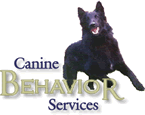 |
Positive, Practical Dog Training for the Real World
Dog Training & Behavior Newsletter
March 2010
Welcome! Welcome to the inaugural issue of Canine Behavior Services' Training & Behavior Newsletter. Each month's issue will feature a new original training and behavior article, a month's worth of Weekly Training Tips and, in the Trainer's Toolbox, one dog training truism (I call these "training-isms") explained. For this first issue, the feature article examines what I have learned is the root of most behavior problems - miscommunication! "Effective Communication in Dog Training" gives a dog's eye view of how to get the most out of your training time, by communicating clearly and effectively, in a way your dog can understand. And for this month's Training-ism, I discuss a simple but powerful dog training principle that can surprise novice and experienced dog owners alike: If It's Right the First Time - Quit! I hope you find the information interesting and enjoyable. Until next time, enjoy your dogs, and Happy Training! Julie Julie Cantrell BSc, CPDT-KA, CDBC
|
||
The Trainer's Toolbox Training-ism: If It's Right the First Time - Quit! This month's training-ism is about training smarter, not harder: if it's right the first time - stop! One common approach to teaching a dog, or maintaining his training, is to practice a certain number of repetitions of each exercise, or train for a certain amount of time. Savvy dog trainers do things differently. Instead of practicing 10 sits in a row, or 5 straight minutes heeling, experienced trainers know it's more important to practice success, than to simply practice. Their goal is to instill a habit of success. What is success? Success means performing the behavior correctly and - in my view anyway - with enthusiasm and enjoyment. So, what does when you quit have to do with it? Many people don't realize that, when you train your dog, your practice sessions build directly upon one another. How you end this session mentally prepares your dog for how he will begin the next one. If a session ends with success, with your dog performing his commands accurately and with enthusiasm, he will come into the next session mentally prepared for success. If a session ends with your dog frustrated, tired, and not able to get anything right, he may come to the next training session less enthused, and more likely to make mistakes. When we make a habit of practicing until the dog becomes tired, bored, or prone to error, we can actually teach our dogs to do poorly at training. On the other hand, when we quit when our dog gets it right - even if that happens the very first time we practice something - we set the stage for not only accuracy, but for enthusiasm and a love of learning. If your dog performs an exercise correctly, switch gears and move on to something different. "Something different" can be a play break, a different exercise, a different way of doing the same exercise, or the end of the training session. By doing this, you maintain the correct behavior and attitude, and reinforce the habit of doing it correctly. Further, you avoid inadvertantly encouraging your dog to get "creative" and make mistakes out of boredom. The final bonus? You keep your training sessions fun and interesting - for you and your dog!
|
February's Weekly Training Tips: |
|
Feature Article: Effective Communication in Dog Training Dogs are amazing creatures. They adapt to countless situations. They are phenomenal at associations: including learning the meaning or implication of many sounds, such as human language. A dog's "vocabulary" can reach upward of 150 distinct words! However, regardless of how smart, how skilled, and how adaptable they are, dogs will never be verbal animals. Their first language, so to speak, is not words, but body language. Because of this, it's only natural that your dog will interpret your words though a "filter" - of body language, facial expression, tone of voice, even your attention. And if one or more of these "disagree" with the words you are using, most dogs will "obey" your body language! In my experience, most snags in the dog training process result from miscommunication, not willfulness, stubbornness, or dominance. While this article is geared toward training the family dog, the fact is that whether your dog is strictly a family pet, a competitor in canine sports, or a full-time working dog, getting the most out of your training time means learning to communicate effectively with your dog. Read full article...
|
This monthly Dog Training & Behavior Newsletter is brought to you courtesy of Julie Cantrell BSc, CPDT-KA, CDBC, Canine Behavior Services. Canine Behavior Services offers a full range of online and local dog training and behavior consulting services. Visit the Canine Behavior Services web site to learn more about how to bring out the "Good dog!" in your dog! |
|
Dog Training & Behavior Newsletter is
Copyright 2010, Julie Cantrell BSc, CPDT-KA, CDBC, Canine Behavior Services. All rights reserved. |
||
Free Training & Behavior Newsletter and Weekly Training Tips If you enjoyed this month's newsletter, sign up here to get yours, right in your inbox! You'll also receive our Weekly Training Tips every Sunday. With each issue, you'll understand your dog better, and enjoy training more! |
